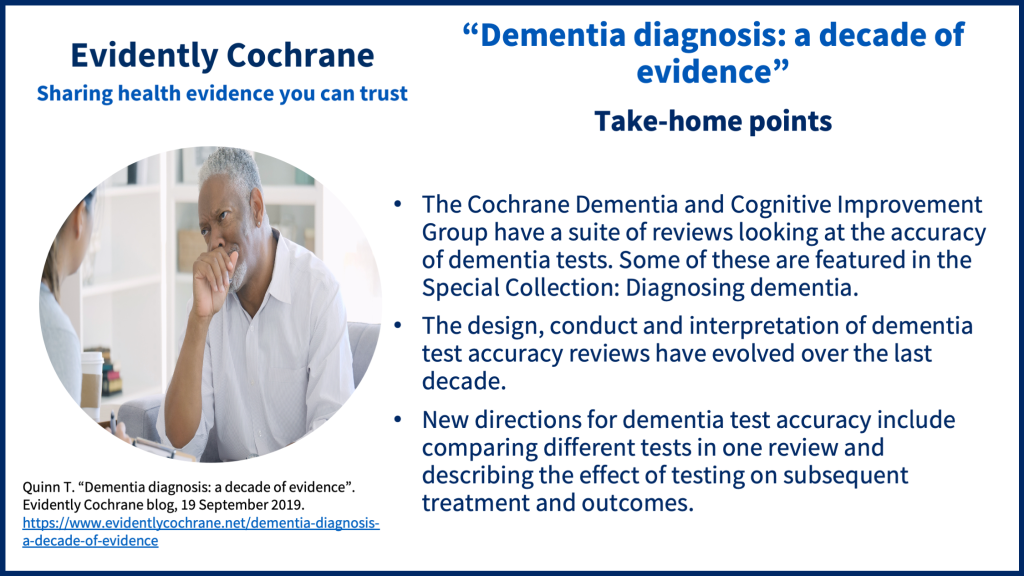In this blog for clinical, research and lay readers, Dr Terry Quinn, the coordinating editor of Cochrane Dementia and Cognitive Impairment, looks at the latest Cochrane evidenceCochrane Reviews are systematic reviews. In systematic reviews we search for and summarize studies that answer a specific research question (e.g. is paracetamol effective and safe for treating back pain?). The studies are identified, assessed, and summarized by using a systematic and predefined approach. They inform recommendations for healthcare and research. around testing for dementia. Terry describes the Dementia Group’s ongoing work on dementia assessment and shares some thoughts on reviews of test accuracy.
Page last updated 28 April 2022 and last checked 21 April 2023
Take-home points
“Dear Dr McShane, I am spending some time in Oxford and wondered if I could help with one of your Cochrane ReviewsCochrane Reviews are systematic reviews. In systematic reviews we search for and summarize studies that answer a specific research question (e.g. is paracetamol effective and safe for treating back pain?). The studies are identified, assessed, and summarized by using a systematic and predefined approach. They inform recommendations for healthcare and research., I am particularly interested in diagnosis of dementia….”
I sent this email to Rupert McShane the coordinating editor of the Cochrane Dementia Group in 2009. At the time, I thought that working on a review would be a useful way to spend my evenings while working in old age psychiatry in Oxford. Almost ten years, multiple reviews and two kids later, I am still working on dementia diagnosis reviews with the team in Oxford.
As we publish our latest reviews and protocols on dementia screening tests (AD-8 [1] Mini-cog[2]) ACE [3]) and collate many of our reviews for the Special Collection: Diagnosing dementia, to coincide with World Alzheimer’s Day [4], I am feeling reflective. What have I learned from all this time spent working on dementia test reviews. It is perhaps a sign of how much Cochrane has influenced my thought processes, that I will structure my blog using the PICO (PopulationThe group of people being studied. Populations may be defined by any characteristics e.g. where they live, age group, certain diseases.; InterventionA treatment, procedure or programme of health care that has the potential to change the course of events of a healthcare condition. Examples include a drug, surgery, exercise or counselling. ; Comparator; OutcomeOutcomes are measures of health (for example quality of life, pain, blood sugar levels) that can be used to assess the effectiveness and safety of a treatment or other intervention (for example a drug, surgery, or exercise). In research, the outcomes considered most important are ‘primary outcomes’ and those considered less important are ‘secondary outcomes’.) format.
Who is being tested?
When we talk about dementia diagnostic tests we need to consider the population who are being tested. Related to this are questions around the setting in which the test is being used and the purpose of the test.[5] A test that performs well in a dedicated memory service may not work so well in a General Practice Surgery and we should not conflate a very brief test designed for initial screening with more detailed neuropsychological batteries or structured interviews that try to give a formal diagnosis. When we designed our first test accuracy reviews we had separate titles for community, primary care and secondary care settings. However, even within these settings there are variations in how a test performs and why the test is being used. For example, within a secondary care category we could include both memory clinics and the Emergency Department, but clearly the testing performed in these areas is very different. Looking at all of our dementia screening test reviews there seems to be a disconnect between setting and evidence. In practice, short screening tests are most likely to be used in acuteA health condition (or episodes of a health condition) that comes on quickly and is short-lived. settings but the majority of research on these tools comes from very specialist memory clinics.

The intervention (the test)
The intervention in these reviews is the test. Although we use the term ‘diagnostic test accuracy’ to describe our reviews, many of the assessments we studyAn investigation of a healthcare problem. There are different types of studies used to answer research questions, for example randomised controlled trials or observational studies. are better thought of as screening or triage tests rather than definitive diagnostic tools – we would not make a diagnosis of dementia on the basis of a five minute pencil and paper test.
There are many dementia screening tests to choose from. In fact, when we reviewed tests used in dementia research it seemed that almost every research team was using a different tool.[6] So, do our Cochrane Reviews help us choose the best test for a particular person? Well hopefully they help a bit, and it is reassuring that our reviews have been used to inform guidelines.[7] However, to be really useful for clinical practice, I think the reviews need to become more sophisticated. Rather than the current approach of looking at the accuracy of tests in isolation, we need to compare tests and perhaps consider more than just test accuracy. Issues such as feasibility, acceptability and cost of the test may be just as important when deciding on the best test for a certain situation. With colleagues in the NIHR Complex Reviews Support we are helping develop methods to allow for comparative analyses of multiple tests. We would hope to apply these methods to our next test accuracy reviews, watch this space.[8]
Gold standard comparator?
In our reviews we assess the test of interest against a gold standardThe intervention that is widely accepted as being the best available, against which new developments should be compared. For example, a particular medicine. comparator. But what is the gold standard for dementia diagnosis? More than any other aspect of our test accuracy work this is the question that has generated the most debate and there have been some ‘robust’ conversations with review authors and peer reviewers. Some would argue that autopsy assessment of the brain is the true gold standard for dementia diagnosis, but few studies have this information and we know that older adults can have brain changes of dementia with no associated memory and thinking problems and vice-versa. More recently there has been interest in using brain scans, blood tests or fluid from the spine to diagnosis dementia.[9] The enthusiasm for these biomarkers has not always matched the research evidence and more than once Cochrane Dementia has had to sound a note of caution around use of these tests.[10] The landscape is evolving rapidly but at the moment we still think that the gold standard for dementia diagnosis is good old fashioned clinical assessment, talking to the person and those that know them well.
Outcomes: looking beyond accuracy
It would seem obvious that the outcome of interest in a test accuracy study would be accuracy. This is certainly the approach we have taken in our reviews, describing tests in statistical terms such as sensitivityA measure of a screening or diagnostic test’s ability to correctly detect people who have the disease./specificity and likelihood ratio. However, as with many aspects of dementia diagnosis research, the reality is more complex than we first anticipated.[11] Accuracy is useful but it doesn’t tell us about the benefits and harms that come from making a diagnosis, it doesn’t tell us whether the diagnosis is accepted by the patient or clinician or tell us anything about what happens once the diagnosis is made. We need to consider the effect that testing has on the person’s future health.[5] This is an issue that we are starting to grapple with in Cochrane Dementia and will probably keep me busy for another ten years.
These are my personal observations, but I would be really keen to hear what you think. So, please get in touch with your thoughts on dementia diagnosis.
More blogs about diagnosing dementia
Diagnosing dementia: is a questionnaire (IQCODE) good enough?
Detecting dementia: how hit and miss is this questionnaire?
Also see our collection Dementia: evidence, experience and resources
Join in the conversation on Twitter with@DrTerryQuinn @CochraneUK and @CochraneDCIG or leave a comment on the blog.
Please note, we cannot give specific medical advice and do not publish comments that link to individual pages requesting donations or to commercial sites, or appear to endorse commercial products. We welcome diverse views and encourage discussion but we ask that comments are respectful and reserve the right to
Terry Quinn has nothing to disclose.




Thanks for a clear, full and helpful review of a very complex area!
You mention very briefly cost. In many cash-strapped provider units (e.g. NHS depts!) this is a major factor. Identifying which are ‘open source’ and which are copyright, & thus only commercially available is a major factor in usage.
Unless a commercial screening or diagnostic tool is dramatically better than an open source one, it will rarely be used, except for research. If it *is* manifestly better, then it may be allowed by commissioners to be part of patient management guidelines.
That then raises the question as to what constitutes ‘dramatically better’ and ‘manifestly better’, and a specific health economic methodology will need to be applied (or invented) to answer this. This is s whole separate discussion!